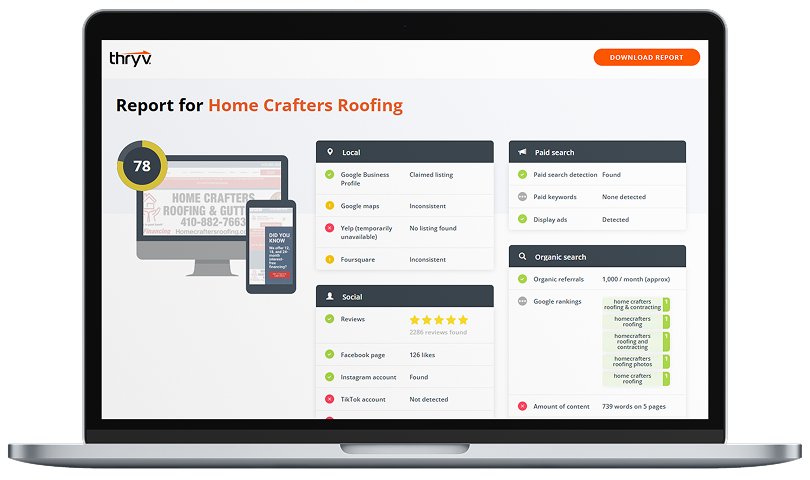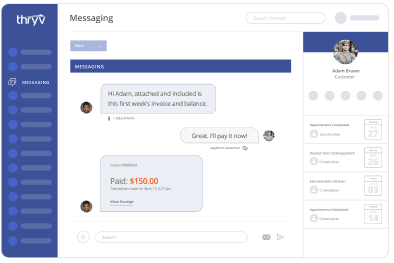In a world where likes, clicks, and follows can feel like progress, it’s easy for small business owners to confuse visibility with profitability. But when it comes to real growth, not all metrics are created equal. The numbers that look impressive, like social media followers or website traffic, don’t always tell you whether your business is actually making money.
In this post, we’ll break down the difference between vanity metrics and the performance indicators that truly drive revenue. You’ll learn which data points to prioritize, how to avoid common measurement traps, and which growth metrics reveal whether your marketing, sales, and customer strategies are working together to build long-term success.
Market and Grow Your Business More Effectively With Marketing Center
Marketing Center helps you attract new customers to your business and shows you which marketing strategies work best for your customers so you don’t waste time and money on the wrong tactics.

Vanity Metrics vs. Metrics That Drive Revenue
It’s easy to get caught up in the numbers that make your business look successful – website visits, social media followers, or email opens. These are called vanity metrics because they’re often surface-level indicators of interest, not impact. They might boost confidence or help with brand awareness, but they don’t necessarily show whether customers are buying, staying loyal, or referring others.
Metrics that truly drive revenue go deeper. They track:
- Customer behavior
- Engagement quality
- Long-term value
While the exact metrics to track might differ depending on the type of business, here are a few that help you get started:
- Conversion rate
- Repeat purchase frequency
- Revenue per client
These metrics help you identify which marketing efforts are actually driving sales and which are generating noise.

Free eBook: Modern Small Business Playbook
Find expert tips and tools to help you streamline communications, automate your marketing efforts, improve your business operations, and more in this free guide.
Download
The common pitfall for many small business owners is focusing too heavily on volume instead of value. For example, thousands of followers don’t matter if they never turn into paying customers. That’s where tools like Thryv’s Marketing Center analytics and client data insights come in. They connect your marketing efforts to your sales results, showing which campaigns lead to actual revenue. With integrated CRM insights, you can see patterns in client behavior (like repeat bookings or referral activity) and make smarter decisions about where to invest your time and budget.
When you start focusing on metrics that reveal proper business health, you gain a clearer picture of what’s driving real results. So, what should you be measuring instead? Let’s look at the key small business growth metrics that directly tie to revenue and how tracking repeat customer behavior can uncover your most significant growth opportunities.
Small Business Growth Metrics to Track Revenue
To understand whether your business is truly growing, focus on metrics that reflect customer value and financial performance, not just activity. A few key performance indicators (KPIs) stand out for small businesses:
- Revenue per client
- Customer acquisition cost (CAC)
- Retention rate
- Conversion rate
- Repeat purchase behavior (frequency of visits, service renewals, referral activity)
Together, these metrics show how efficiently you’re attracting customers, how much each one contributes to your bottom line, and how well you’re keeping them over time.
Tracking these numbers doesn’t have to be complicated. Start by comparing your marketing spend to new client revenue to calculate CAC, then use your CRM or analytics dashboard to measure repeat sales and average purchase size. A rising revenue per client or improved retention rate signals that your efforts are paying off. Platforms like Thryv simplify this by centralizing your client and marketing data, giving you a clear view of which campaigns and customer relationships drive the most revenue.
One of the most powerful indicators of sustainable growth is repeat purchase behavior. When customers come back, it means your product or service delivers enough value to earn their loyalty and trust. By monitoring patterns like frequency of visits, service renewals, or referral activity, you can identify your most valuable clients and design campaigns that nurture those relationships. Tools like Thryv’s client data and CRM insights help small businesses spot these trends in real time, turning everyday transactions into long-term growth opportunities.
Measuring for Meaningful Growth
At the end of the day, growth isn’t about chasing the highest numbers. It’s about tracking the right ones. By moving past vanity metrics and focusing on KPIs that reflect real customer value and revenue impact, small businesses can make smarter, more confident decisions.
When you understand which efforts drive repeat purchases, higher retention, and stronger client relationships, you can invest your time and resources where they matter most. With tools like Thryv’s Marketing Center analytics and CRM insights, it’s easier than ever to connect your marketing data to actual business outcomes, helping you measure not just activity, but real progress toward long-term growth.

Modern Small
Business Playbook
Find expert tips and tools to help you streamline communications, automate your marketing efforts, improve your business operations, and more in this free guide.


